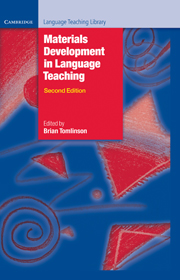Book contents
- Frontmatter
- Contents
- Preface
- Glossary of basic terms for materials development in language teaching
- Acknowledgements
- 1 Introduction: principles and procedures of materials development
- Part A Data collection and materials development
- 2 Using corpora in the language classroom
- 3 Concordances in the classroom without a computer: assembling and exploiting concordances of common words
- 4 Telling tails: grammar, the spoken language and materials development
- Comments on Part A
- Part B The process of materials writing
- 5 A framework for materials writing
- 6 Writing course materials for the world: a great compromise
- 7 How writers write: testimony from authors
- Comments on Part B
- Part C The process of materials evaluation
- 8 The analysis of language teaching materials: inside the Trojan Horse
- 9 Macro- and micro-evaluations of task-based teaching
- 10 What do teachers really want from coursebooks?
- 11 The process of evaluation: a publisher’s view
- Comments on Part C
- Part D The electronic delivery of materials
- 12 Developing language-learning materials with technology
- 13 New technologies to support language learning
- Comments on Part D
- Part E Ideas for materials development
- 14 Seeing what they mean: helping L2 readers to visualise
- 15 Squaring the circle – reconciling materials as constraint with materials as empowerment
- 16 Lozanov and the teaching text
- 17 Access-self materials
- Comments on Part E
- Conclusions
- Recommended reading
- Index
Conclusions
Published online by Cambridge University Press: 09 February 2023
- Frontmatter
- Contents
- Preface
- Glossary of basic terms for materials development in language teaching
- Acknowledgements
- 1 Introduction: principles and procedures of materials development
- Part A Data collection and materials development
- 2 Using corpora in the language classroom
- 3 Concordances in the classroom without a computer: assembling and exploiting concordances of common words
- 4 Telling tails: grammar, the spoken language and materials development
- Comments on Part A
- Part B The process of materials writing
- 5 A framework for materials writing
- 6 Writing course materials for the world: a great compromise
- 7 How writers write: testimony from authors
- Comments on Part B
- Part C The process of materials evaluation
- 8 The analysis of language teaching materials: inside the Trojan Horse
- 9 Macro- and micro-evaluations of task-based teaching
- 10 What do teachers really want from coursebooks?
- 11 The process of evaluation: a publisher’s view
- Comments on Part C
- Part D The electronic delivery of materials
- 12 Developing language-learning materials with technology
- 13 New technologies to support language learning
- Comments on Part D
- Part E Ideas for materials development
- 14 Seeing what they mean: helping L2 readers to visualise
- 15 Squaring the circle – reconciling materials as constraint with materials as empowerment
- 16 Lozanov and the teaching text
- 17 Access-self materials
- Comments on Part E
- Conclusions
- Recommended reading
- Index
Summary
I would like to end this book by highlighting certain messages which seem to have been communicated throughout the book and to suggest ways in which we can gain from them.
We should be proud but not complacent about the progress made in materials development
We have reached a situation in which high-quality materials are available throughout the world to help learners to learn languages. These materials have taken advantage of recent developments in technology and of our recently increased knowledge of how languages are learned (Tomlinson 2011). But many learners still fail to achieve a satisfactory level of communicative competence and many teachers and learners are still not happy with the materials they are using. We must not sit back and say that what we have is good enough, but rather continue to strive towards the development of materials which give even more learners the chance of satisfaction and success.
We need to find out more about the outcomes of existing materials
There has been very little research into the actual learning outcomes of language-learning materials. Publishers have been understandably reluctant to conduct longitudinal and expensive research into the effects of books which they have already published and, also understandably, they are likely to keep whatever research they do confidential. Academics have been wary of undertaking research which would require massive expenditure of time and resources and which would involve great difficulty in controlling the variables in order to reach any conclusive results. But are we really being responsible and professional when we judge the effectiveness of a book by the number of copies it sells? Or by its popularity judged by responses to questionnaires? Or by a general impression that most of the activities in it ‘work’? We need to (and could) find out more about the actual learning outcomes of types of materials if we really want to help those learners who currently fail. Recently more and more postgraduate students are conducting their research projects on materials development (Tomlinson and Masuhara 2010 ), but not many of them are conducting longitudinal research focusing on the effects of particular types of materials.
Information
- Type
- Chapter
- Information
- Materials Development in Language Teaching , pp. 437 - 442Publisher: Cambridge University PressPrint publication year: 2011
